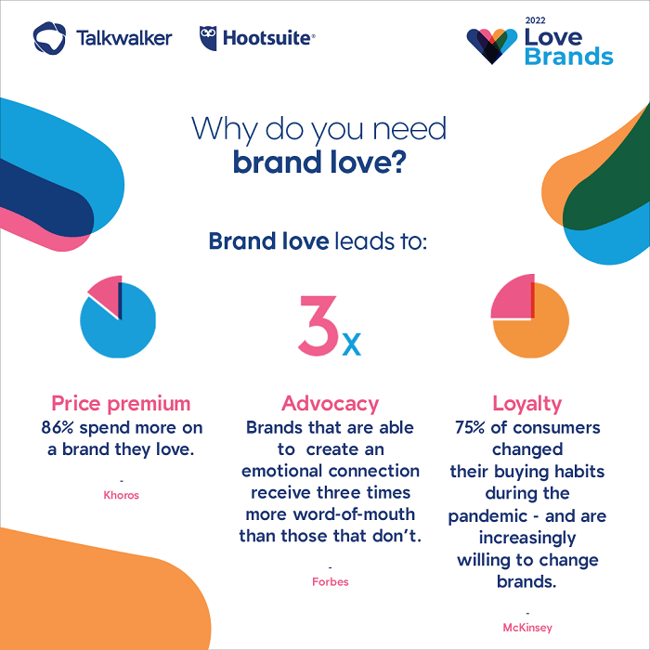Creating brand love can help boost sales, and strengthen your connection with your consumers. But what are the best marketing KPIs to measure something as intangible as love? Let’s dig deeper into the metrics you can use to measure yours.
You can start measuring how loved you are on social media straight away with our free Social Search. Just click below.
How do you measure brand love?
"Brands that focus on eliciting emotions tend to have better and deeper relationships with their customers, cultivating an environment of loyalty and advocacy, essential for long-term success."
Lydia Michael, Author of Brand Love — Building Strong Consumer-Brand Connections.
It’s great when consumers love your brand. It means they’ll be:
- more loyal to you
- willing to spend more money on your products
- 3x more likely to advocate for your brand
What’s not to love about that?
The difficulty is effectively measuring that brand love. As it’s an emotional connection, it’s hard to create tangible brand KPI metrics that you can monitor. This makes it hard for brands to understand how consumers feel about their products. And difficult to see how their marketing efforts directly impact that brand love.
That’s why Talkwalker developed its Brand Love Index.
The Brand Love Index
Talkwalker’s Brand Love Index uses a quantitative score that brands can use to see how well-loved their brand is. Brands can use this as an industry benchmark.
It uses 3 scores -
- Brand passion
- Brand trust
- CSAT (Customer satisfaction)
These score on a scale of -5 to 5, using the 3 scores to create the final marketing KPI.
How was the Brand Love Index created?
The Brand Love Index uses Talkwalker’s Social Benchmarking. We use it to track brand conversations across the internet, including social media posts, reviews, blogs, and forums. We also use image recognition & video analytics to see how people interact with brands in videos and pictures.
We analyzed over 1,500 brands in over 2.6 billion conversations. This revealed what consumers thought about these brands in their day-to-day lives. And identified the brands that consumers love.
Why is brand passion a key marketing KPI?
Consumers are no longer just looking for products they can use. They want products they can be passionate about. This means they have a genuine, emotional connection to the brand.
Passion can be a great loyalty driver. Why would you buy brand B or brand C, when you’re already passionate about brand A?
Consumers can become passionate about a brand in numerous ways.
Nostalgic connections
Nostalgia is rose-tinted. As we look back, we often remember happier times. By connecting your brand to childhood memories or experiences, you can rekindle that positivity for your product. This is the type of passion historical brands have built around them, leading to potentially decades of brand loyalty.
Societal/peer influence
This is common within the tech industry. Consumers get passionate about a particular brand based on what they think is the leading product. Apple vs. Android, Xbox vs. PlayStation, and even Coke vs. Pepsi. External influencers often impact this type of brand passion, as consumers jump onto brands that are more ‘now.’
Social responsibility connections
Consumers are increasingly passionate about improving the issues impacting the world, whether environmental, societal, or economic. When a brand aligns with these issues and genuinely tries to make a difference, it fosters connections with consumers.
No wonder, a majority of our 50 most loved brands actively focus on sustainability.
How to measure brand passion
To measure brand passion, we looked at brand conversations that showed passion-related words or phrases alongside the brand name. We also monitored emojis and sentiment analysis to find positive feelings towards a brand.
We also considered negative brand mentions (or as most people call it, brand hate).
These mentions create a Passion score from -5 to 5.
I'm watching this show on Netflix called Inventing Anna about a woman who cons everyone into believing she's a millionaire and I probably shouldn't be rooting for her but I LOVE this show!
— BrooklynDad_Defiant!☮️ (@mmpadellan) February 20, 2022
An example post demonstrating brand passion
Why is brand trust an important marketing KPI?
In the age of disinformation, don’t underestimate the value of trust.
It’s more critical than ever. During the pandemic, we saw a rise in misinformation and a lack of consistent clarity from credible sources. This led many consumers to the brands they loved for help.
That trust can pay off with 81% of consumers needing to trust a brand to consider buying from them.
The best way to build brand trust is through consistent, quality products, and messaging.
Be more consumer-centric
Consumers trust brands that ‘get them.’ But this consumer connection isn’t created by fluke. Trusted brands listen to their consumers, and understand exactly what makes them tick. Whether that’s knowing the latest trends, or launching products that people want.
Transparency is key
The internet is a vast open source of information. If consumers have a question about your brand, they will find an answer. It’s whether that answer comes from you or not.
Transparency helps build trust, as consumers know they can get the answers that matter to them from you. And win-win, it helps prevent brand disinformation at the same time.
Be authentic
Consumers don’t want to be sold to. Instead, they want authentic conversations. That means no technobabble or marketing buzzwords. But a genuine empathy towards them and their problems.
How to measure brand trust
To measure brand trust, we analyzed conversations that related to trust or similar phrases alongside the brand name.
Again, we also looked for mentions that were distrustful towards a brand.
These mentions create a Trust score from -5 to 5.
Got me one of those @SteelSeries headsets for review and have 0 complaints after spending three weeks with it. Trust me when I tell y'all - I highly recommend the Arctis Nova Pro Wireless headset.@137pm + @ONE37gg https://t.co/dBGXFjufsw
— Elton R. Jones (@theerj) June 23, 2022
An example of a consumer showing trust in their favorite brand
Why should brands monitor CSAT as a marketing KPI?
If the customer is royalty, customer service is the entourage that keeps them in power.
With so much online competition, you need top-level customer support to stop your consumers from leaving. 81 percent of consumers are more likely to make further purchases if they have a positive customer service experience. Treat your customers right, and they will spend more.
Creating an amazing customer experience starts with the basics.
Fix problems before they become problematic
We all know the excitement of buying a new product. Preordering, the build-up of anticipation as you await for it to arrive. All the excitement. And then it arrives, and it’s faulty.
All that potential brand love vanishes in a puff of disappointment.
But there is a way to win that back. Consistent consumer listening can help you identify ongoing issues, and tackle them effectively.
Deal with the issue before the client has to. By proactively promoting a solution, instead of waiting for complaints, you’re more likely to win that brand love. And avoid bad reviews.
Plus, you can win more customers, as 70% of unhappy customers whose issues are resolved say they will purchase from that same company again.
Find the indirect complaints
Not everyone wants to directly complain about every issue they face. But they are willing to vent on social media when things go wrong.
Using social listening to monitor brand, product, or service mentions, can help you find these indirect complaints. Then you can either attempt to fix them by contacting the consumer or use the data to find broader issues and fix them.
Talk like your customers think
Listen to your consumers to understand how their minds work. This can:
- Identify pain points
- Uncover the nuances of their communications
- Find the topics they like to discuss
This can help you shape all your communications to be more aligned with their thoughts. Helping make your brand more relevant, and improve your overall customer experience.
How to measure customer satisfaction
To create a customer satisfaction score, we analyzed social media posts and review data, to identify brand customers. We then used sentiment analysis plus review/star ratings, to determine the level of (dis)satisfaction.
These mentions create a CSAT score from -5 to 5.
@AvivaUK amazing quick and easy thanks for sorting this out for me 👍🏽
— VibeVision (@Benzino1997) March 12, 2022
An example post showing the response to excellent customer service
Talkwalker Social Benchmarking
Talkwalker Social Benchmarking provides all these scores to enable your brand to understand just how loved you are, in real time.
By comparing this with your competitors, you’ll arm yourself with the insights to build your brand love strategy. And enable a more customer-centric approach. Start diving into your social data with our free Social Search. Just click below.




